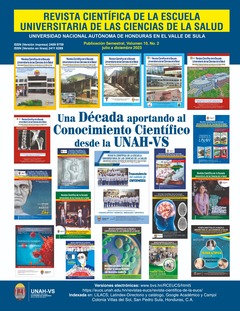Implementation of the nursing care process in patient with Fournier's Gangrene
DOI:
https://doi.org/10.5377/rceucs.v10i2.18058Keywords:
alcoholism, nursing care, Fournier's gangreneAbstract
Fournier's gangrene is a type I necrotizing fasciitis that affects men and women at any age, originates from an infection of the perianal, genital, and lower third of the abdomen, has a polymicrobial etiology, and can spread to the clavicle; this pathology presents a high mortality rate, which requires prompt and aggressive treatment. Aim: identify the needs of the Fournier's Gangrene patient, and implement the nursing care process (PAE), carrying out evaluation and elaboration of the diagnoses according to the Taxonomy of the North American Nursing Diagnosis Association (NANDA). The case of a 38-year-old male patient is shown, who presented an ulcerated lesion of approximately 8 cm in length in the perianal area, with irregular, hardened, fetid edges, accompanied by pain on palpation, hot to the touch, presence of muscle involvement (external sphincteran- al), located in the anterior perianal region, which communicates with the contralateral region of the right gluteus, accompanied by inflammatory changes, approximately 5cc of purulent discharge. Patient underwent debridement and cleaning in the affected region; In the nursing care process (PAE), the evaluation and elaboration of the diagnoses was carried out according to the NANDA Taxonomy: 1) Acute pain 2) Deterioration of tissue integrity 3) Risk of infection 4) Emotional instability. In addition, the intervention plan was developed with Nursing Outcomes Classification (NOC) and Nursing Interventions Classification (NIC).
Downloads
342




